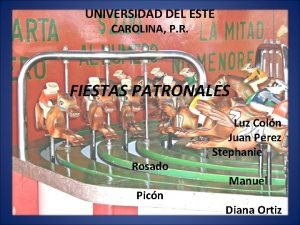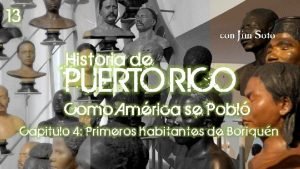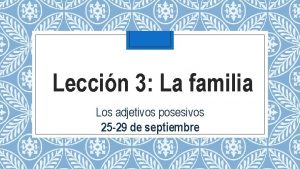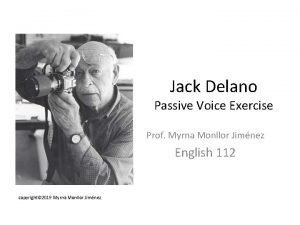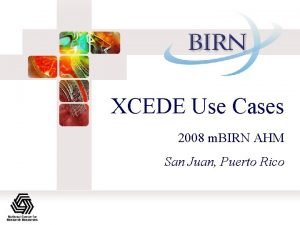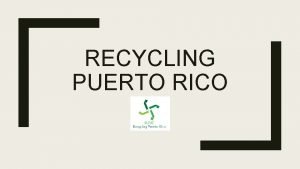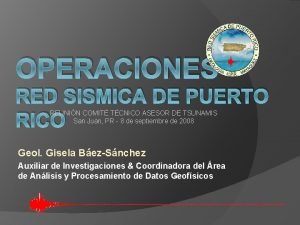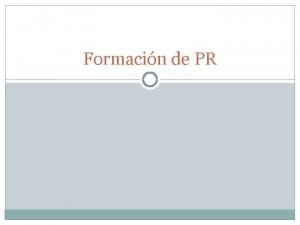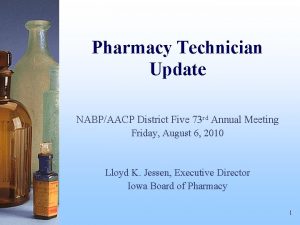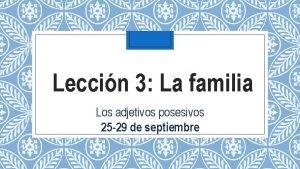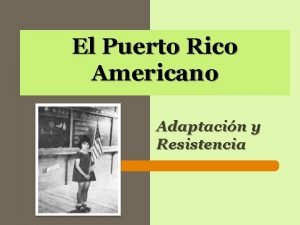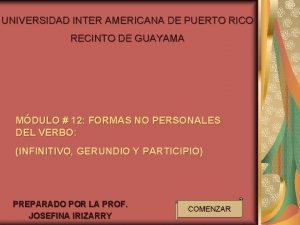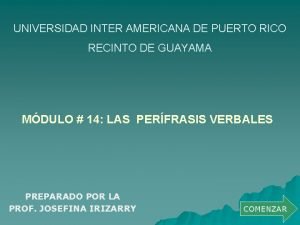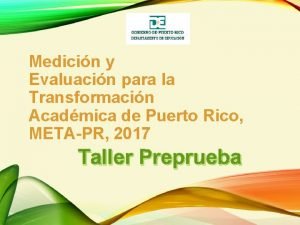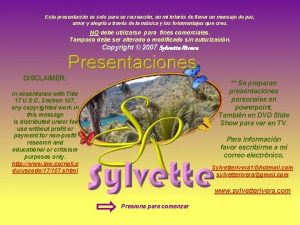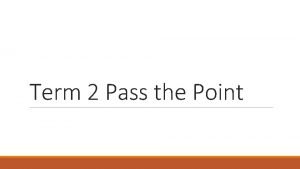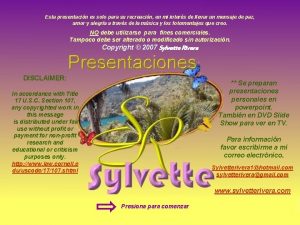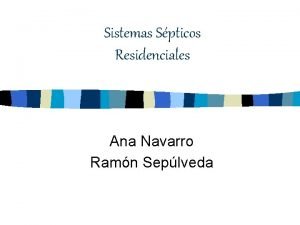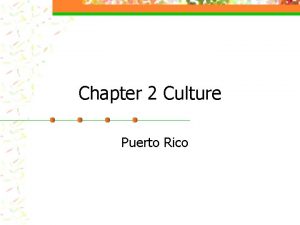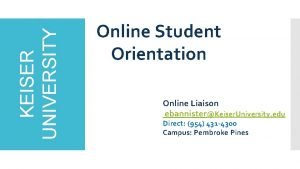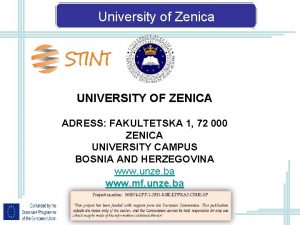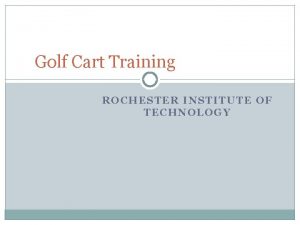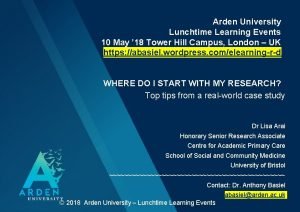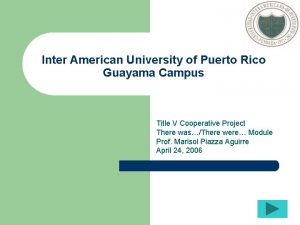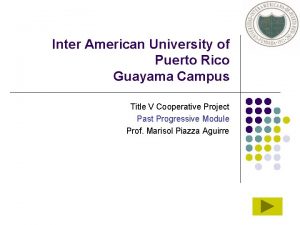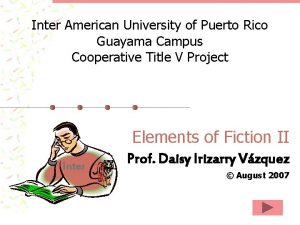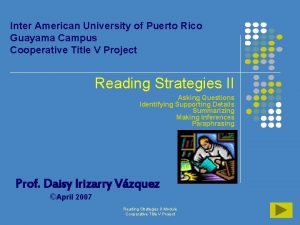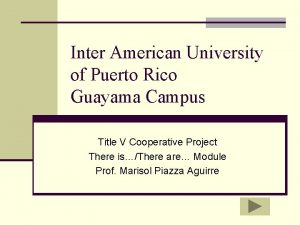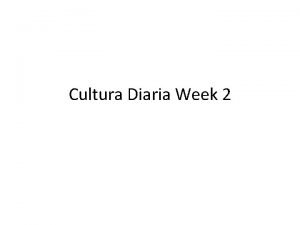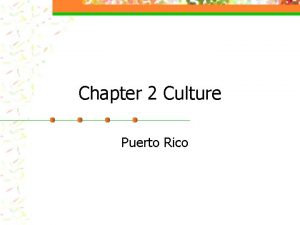Inter American University of Puerto Rico Guayama Campus

































































- Slides: 65

Inter American University of Puerto Rico Guayama Campus Cooperative Title V Project Demonstrative Adjectives Module Prof. Daisy Irizarry Vázquez March 2008 ©

Buttons You will use the following buttons to navigate through this module. The buttons and their meanings follow: use it to go back to the first or home slide use it to move to the next slide use it to return to the previous slide

Purpose This module will give you an opportunity to review the use of demonstrative adjectives. Demonstrative adjectives are studied in your GEEN 1101 -English as a Second Language I or any basic grammar/oral communication course

Introduction Adjectives tell you more about nouns. In English adjectives do not change forms; they are always singular (even if the noun is plural). You can use several adjectives before a noun, or you can use the adjective on its own in a phrase. There are different kinds of adjectives, and they come in a certain order. In this module we will do the grammar of demonstrative adjectives. I hope you find it very useful!

Module’s Objectives

General Objective o. After studying this module, you will be able to use the demonstrative adjectives accurately in affirmative, negative, and interrogative statements.

Specific Objectives o Upon completion of the module on demonstrative adjectives, you will use the adjective according to: n n n the number in the noun: singular or plural. the position of the noun in relation to the speaker: close or father. the kind of statement: affirmative, negative, or interrogative.

Pre-Test

Part I. For each of the following sentences, fill in the blank with this or these. 1. _____ bicycle is not mine. 2. _____ books are expensive. 3. Is ____ jacket too large? 4. _____ boots are not warm. 5. There are toys are on the floor. Are _____toys yours, Sammy? 6. Does _____ bus go downtown? 7. _____ is his camera. 8. _____ trees are over one hundred years old. 9. Is _____ flower a daffodil? 10. _____ women will perform the parody.

Part II. For each of the following sentences, fill in the blank with that or those. Are _____children on vacation? ____ hovercraft is fantastic. ____ planes fly to Geneva. Are _______peacocks? _______lakes are very deep. Are _____ radishes? _____ suitcases are lost. _______main entrances are for the general public. 19. Which toys do you like? ____toys, Mom. 20. _____ is not a maple tree. 11. 12. 13. 14. 15. 16. 17. 18.

Answer Key to Pre-Test 1. This 2. These 3. this 4. These 5. these 6. this 7. This 8. These 9. this 10. These 11. those 12. That 13. Those 14. those 15. those 16. Those 17. Those 18. Those 19. That 20. That

Pre-Test Assessment 20 -18 Excellent Go to the Post Test. 17 -16 Very Good Review the incorrect answers and go to the Post Test. 15 -14 You need some practice Review the incorrect answers; study the information presented in this module; do the assessment exercise and then go to the Post Test. 13 or less You need to Study the module; review the information carefully work the and do the assessment exercise. Then, you can go complete to the Post Test. module I wish you did well!

Grammar of Demonstrative Adjectives

Adjectives (Review) o Adjectives modify nouns and pronouns. o Although adjectives usually precede the words they modify, they may follow them and be separated by a form of the verb be or a substitute verb such as seems or feels.

Adjectives (Review) o Examples of adjectives: n The beautiful rose p The rose is beautiful p The rose looks beautiful

Demonstrative Adjectives o A demonstrative adjective points out which item, object, person, or concept is being referred to. o In English, demonstrative adjectives always come before the noun they refer to.

Demonstrative Adjectives o These toys are new. That book is very interesting. o In the above sentences, the adjectives these and that point out the toys and book, respectively. o Adjectives which point out which person or a thing is spoken of are Demonstrative Adjectives.

Demonstrative Adjectives o These are special adjectives or determinersused to identify or express the relative position of a noun in time or space. o A demonstrative adjective comes before all other adjectives in the noun phrase. o Some common demonstrative adjectives are this, that, these, and those.

Demonstrative Adjectives 1 Affirmative Sentences o The words this, that, these and those can be used immediately preceding a noun, in which case they can be referred to as demonstrative adjectives. o Examples: This pie is made with apples. That idea seems practical. These people are my friends. o In the preceding examples, this, that, these and those act as adjectives, modifying the nouns pie, idea, people and trees, respectively.

Demonstrative Adjectives 2 Affirmative Sentences o This and these are used to indicate persons or things that are close to the speaker or writer. o This takes a singular verb, and is used when referring to a single person or thing. o Examples: n n This man is my brother. This sports car belongs to him.

Demonstrative Adjectives 3 Affirmative Sentences o These takes a plural verb, and is used when referring to more than one person or thing. o Examples: n These young handsome men are my brothers. n These English books belong to him.

Demonstrative Adjectives 4 Affirmative Sentences o That and those are used to indicate persons or things that are farther or away from the speaker or writer. o That takes a singular verb, and is used when referring to a single person or thing. o Examples: n That garden looks like one I saw in a magazine. n That sports car belongs to him.

Demonstrative Adjectives 5 Affirmative Sentences o Those takes a plural verb, and is used when referring to more than one person or thing. o Examples: n Those children are wearing the Field Day t-shirt. n Those rappers were already famous in the 90 s.

Demonstrative Adjectives 6 Negative Sentences o The demonstrative adjectives do not change in Negative Sentences. o Use them as in affirmative sentences, but do not forget to match the number and distance from the speaker of the adjective with the noun pointed at.

Demonstrative Adjectives 7 Negative Sentences o Examples: n This dress is not black but navy blue. n These letters were on my desk yesterday. n That pen drive is not full yet. n Those professors did not work here last year.

Demonstrative Adjectives 8 Interrogative Statements o Demonstrative Adjectives answer the question Which? o Examples: n Which ice cream would you like? That cheesecake ice cream. n Which shoes? Those shoes on the top shelf.

Demonstrative Adjectives 9 Interrogative Statements o Demonstrative Adjectives are used in Simple Present or Simple Past questions. o Examples: n n n Does that jacket protect you from this weather? Do these shoes match my dress? Does that bookstore sell bilingual dictionaries? Do those baseball players know about the food poisoning? Did you take that belt from my closet? Did you call these reporters?

Assessment Exercise

Part I. Complete the statement with the correct Demonstrative Adjective: this or these 1. Stephen seemed angry after he finished ______new book. 2. Martin's diligent studying has made the difference in ______ grades. 3. Before the next meeting, the president will meet with ____ marketing staff. 4. Alabama's governor replied quickly to ______ blunt questions. 5. Do you want _______ shoes? They are almost new.

Part II. Complete the statement with the correct Demonstrative Adjective: that or those 6. Are ____ computers equipped with an antivirus? 7. Do you know ____ lady? She is calling your name. 8. Which toothbrush did you buy? _____ toothbrush with happy faces. 9. ______ car is European. 10. _____ buses take you to the water park.

Assessment Answer key 1. this 2. these 3. this 4. these 5. these 6. those 7. that 8. that 9. This 10. Those

Assessment 10 -9 Excellent Go to the Post Test. 8 -7 Very Good Review the incorrect answers and go to the Post Test. 6 -5 You need some practice Review the incorrect answers; study the information presented in this module again; do the assessment exercise again and then go to the Post Test. 4 or less You need to Study the module; review the information carefully work the and do the assessment exercise. Then, you can go complete to the Post Test. module again Success is a little walk away!

In Summary o Demonstrative adjectives indicate which one of something you are talking about. o Remember that in English, there are different forms of the demonstrative adjective according to the number of items and where they are located. o singular plural this these closer that those farther

In Summary o The demonstrative adjective is used directly in front of a noun - there is no article. n n This book is inspiring. That house looks gorgeous. Those stamps are collector’s items. These computers belong to Lab I.

Summary Practice: Select the correct demonstrative adjective 1. ____ is his pen. A. This B. These C. Those 2. _______ girls are Australian. A. Those B. That C. This

3. Has _______ chair been painted? A. these B. this C. those 4. _______ watches are not expensive. A. That B. Those C. This

5. Does _____ train usually arrive on time? A. that B. these C. those 6. Was ______ your friend? A. those B. that C. these

7. ______ are my cousins. A. Those B. This C. That 8. ____ is a swan. A. That B. These C. Those

9. Do _____ notebooks belong to you? A. that B. this C. these 10. _______ are the places we will visit. A. This B. These C. That

Post Test

Part I. Select the sentence that correctly changes the subjects and verbs from the singular to the plural. Example: Is this cake ready? A. Are these cakes ready? B. Are ready this cakes? C. Is these cakes ready? D. Is those cakes ready? E. Are that cakes ready? A is the correct answer.

Select the sentence that correctly changes the subjects and verbs from the singular to the plural. 1. Was this project finished last week? A. Were those project finished last week? B. Were this projects finished last week? C. Were these projects finished last week? D. Was that projects finished last week? E. Were those project finished last week?

2. Is that radiator working? A. Are those radiators working? B. Is these radiator working? C. Are that radiators working? D. Is these radiators working? E. Is that radiators working?

3. This picture is ours. A. These picture is ours. B. These pictures are ours. C. That pictures is ours. D. That pictures are ours. E. This pictures are ours.

4. That painting has been completed. A. That painting have been completed. B. That paintings has been completed. C. Those paintings has been completed. D. That painting has been completed. E. Those paintings have been completed.

5. This sofa was designed by his aunt. A. This sofas was designed by his aunt. B. These sofa were designed by his aunt. C. This sofa were designed by his aunt. D. These sofas were designed by his aunt. E. Those sofas was designed by his aunt.

6. That blouse does not need to be altered. A. Those blouses do not need to be altered. B. That blouses does not need to be altered. C. These blouses does not need to be altered. D. That blouse do not need to be altered. E. Those blouses does not need to be altered.

7. This table is made of wood. A. This table are made of wood. B. These tables is made of wood. C. These tables are made of wood. D. Those tables is made of wood. E. This tables are made of wood.

8. Has that student seen the play? A. Has that students seen the play? B. Have that student seen the play? C. Has those students seen the play? D. Has those student seen the play? E. Have those students seen the play?

9. This umbrella is new. A. This umbrellas are new. B. These umbrellas are new. C. These umbrella are new. D. Those umbrellas is new. E. This umbrella are new.

10. That river flows through the mountains. A. That rivers flows through the mountains. B. Those river flow through the mountains. C. That river flow through the mountains. D. Those rivers flow through the mountains. E. Those river flow through the mountains.

Part II. Select the sentence that correctly changes the subjects and verbs from the plural to the singular. Example: These pictures were on sale. A. This picture was on sale. B. These picture was on sale. C. These pictures were on sale. D. This pictures were on sale. E. That picture was on sale.

Select the sentence that correctly changes the subjects and verbs from the plural to the singular. 11. These arrangements were necessary. A. These arrangement were necessary. B. This arrangements was necessary. C. These arrangement was necessary. D. These arrangements were necessary. E. This arrangement was necessary.

12. Those colors are beautiful. A. That color is beautiful. B. That color are beautiful. C. That colors are beautiful. D. Those colors are beautiful. E. Those colors beautiful are.

13. Have those tables been polished? A. Have those table been polished? B. Have these tables been polished? C. Has that table been polished? D. Have this table been polished? E. Has those table been polished?

14. These shirts are clean. A. These shirts are clean. B. These shirts are clean. C. This shirt is clean. D. These shirts are clean. E. This shirts are clean.

15. Those windows are on the west side of the house. A. These window is on the west side of the house. B. That window is on the west side of the house. C. Those window are on the west side of the house. D. That windows are on the west side of the house. E. Those windows are on the west side of the house.

16. Are these bells too loud? A. Are these bells too loud? B. Is this bells too loud? C. Are that bells too loud? D. Are these bell too loud? E. Is this bell too loud?

17. Are these answers correct? A. Is this answers correct? B. Are these answers correct? C. Is this answer correct? D. Are these answer correct? E. Is this answer corrects?

18. These boys like to play soccer. A. This boy likes to play soccer. B. These boys like to play soccer. C. These boy likes to play soccer. D. Those boys like to play soccer. E. This boys likes to play soccer.

19. Those flowers are sufficient for the arrangement. A. These flowers are adequate for the arrangement. B. That flower are adequate for the arrangement. C. Those flowers are adequate for the arrangement. D. That flower is adequate for the arrangement. E. Those flower is adequate for the arrangement.

20. Those curtains are crimson. A. This curtains is crimson. B. Those curtains are crimson. C. That curtains are crimson. D. Those curtain are crimson. E. That curtain is crimson.

Post-Test Answer Key Part I. 1. C 2. A 3. B 4. E 5. D 6. A 7. C 8. E 9. B 10. D Part II. 11. E 12. A 13. C 14. C 15. B 16. E 17. C 18. A 19. D 20. E

Post-Test Assessment 20 -18 Excellent Go to the Post Test. 17 -16 Very Good Review the incorrect answers and go to the Post Test. 15 -14 You need some practice Review the incorrect answers; study the information presented in this module; do the assessment exercise and then go to the Post Test. 13 or less You need to Study the module; review the information carefully work the and do the assessment exercise. Then, you can go complete to the Post Test. module Great Job!

Feedback! Dear Student I am sure that you enjoyed reviewing or studying for the first time, the demonstrative adjectives. Now, you should use them in improved ways. Remember that your professor and English Laboratory Technician are available to assist you with further explanations and exercises on this topic. I wish you well! Prof. Daisy Irizarry Vázquez
 Ejemplos de fiestas patronales
Ejemplos de fiestas patronales Arahuacos en puerto rico
Arahuacos en puerto rico Escudo de puerto rico para niños
Escudo de puerto rico para niños Reciclaje de papel en puerto rico
Reciclaje de papel en puerto rico Osha 300 puerto rico
Osha 300 puerto rico Puerto rico webquest
Puerto rico webquest Mapa politico de puerto rico
Mapa politico de puerto rico Puerto rico
Puerto rico Puerto rico fun facts
Puerto rico fun facts Sustantivos posesivos
Sustantivos posesivos El cuento de juan bobo
El cuento de juan bobo El fanguito puerto rico
El fanguito puerto rico Puerto rico language
Puerto rico language Alexandra cardona puerto rico
Alexandra cardona puerto rico Ahm puerto rico
Ahm puerto rico Elizabeth torres rodriguez
Elizabeth torres rodriguez Recycling in puerto rico
Recycling in puerto rico Redsismica puerto rico
Redsismica puerto rico Puerto rico capital
Puerto rico capital Como se formó puerto rico geologicamente
Como se formó puerto rico geologicamente Huracan hortensia en puerto rico
Huracan hortensia en puerto rico Ptcb exam puerto rico
Ptcb exam puerto rico Lidar puerto rico
Lidar puerto rico Los tios de ellos regresan de puerto rico el sabado
Los tios de ellos regresan de puerto rico el sabado Educacion continua abogados puerto rico
Educacion continua abogados puerto rico Kyokushin karate puerto rico
Kyokushin karate puerto rico Guam and puerto rico
Guam and puerto rico Gerundio de puerto rico
Gerundio de puerto rico Que es una perifrasis verbal
Que es una perifrasis verbal Pearson access next puerto rico
Pearson access next puerto rico Huracan hortensia en puerto rico
Huracan hortensia en puerto rico Puerto rico patria mia la tierra de mis amores
Puerto rico patria mia la tierra de mis amores Jibaro dress
Jibaro dress Www.proyectosalonhogar.com
Www.proyectosalonhogar.com Loihi seamount
Loihi seamount Guam and puerto rico
Guam and puerto rico Sezma shrestha
Sezma shrestha Tabla contributiva 2020 puerto rico
Tabla contributiva 2020 puerto rico Puerto rico patria mia la tierra de mis amores
Puerto rico patria mia la tierra de mis amores El yunque national forest puerto rico
El yunque national forest puerto rico Llanos costaneros
Llanos costaneros Llanos costaneros de puerto rico
Llanos costaneros de puerto rico Pozo séptico prefabricado puerto rico
Pozo séptico prefabricado puerto rico 7 wonders of the world puerto rico
7 wonders of the world puerto rico Est puerto rico
Est puerto rico Puerto rico
Puerto rico Proper adjective for bahamas
Proper adjective for bahamas Inter american accreditation cooperation
Inter american accreditation cooperation Brenau university canvas
Brenau university canvas Keiser bookstore online
Keiser bookstore online Nau family housing
Nau family housing Fordham summer session 1
Fordham summer session 1 Ambo university woliso campus
Ambo university woliso campus Campus of university of zenica
Campus of university of zenica University of san francisco san jose campus
University of san francisco san jose campus Transilvania university of brasov campus
Transilvania university of brasov campus Sebelas maret university campus
Sebelas maret university campus Dr kihn emilie
Dr kihn emilie Lander university campus map
Lander university campus map Ambo university
Ambo university Kodolanyi janos university budapest campus
Kodolanyi janos university budapest campus Preston university islamabad campus
Preston university islamabad campus Meiji university ikuta campus
Meiji university ikuta campus Arden university tower hill campus
Arden university tower hill campus Catholic university of korea songsin campus
Catholic university of korea songsin campus Saint louis university campus map
Saint louis university campus map
